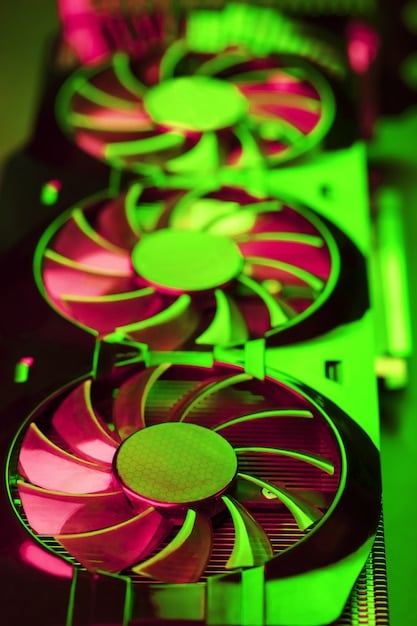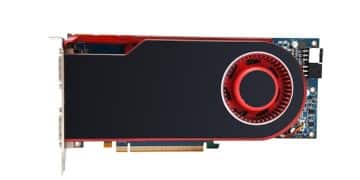NVIDIA RTX 4060 Ti: 16GB Worth It for Future-Proofing?

The NVIDIA RTX 4060 Ti offers two variants, an 8GB and a 16GB model; deciding if the doubled memory is worth the extra cost involves considering current and future gaming demands, as well as professional applications that benefit from larger frame buffers.
Is the NVIDIA RTX 4060 Ti 16GB version worth the extra cost for future-proofing your gaming rig, or is the 8GB model sufficient? This is a question many gamers and content creators are asking themselves.
NVIDIA RTX 4060 Ti: A Comprehensive Overview
The NVIDIA RTX 4060 Ti is a mid-range graphics card designed to deliver excellent performance for 1080p and 1440p gaming. Available in both 8GB and 16GB variants, it aims to bridge the gap between affordability and high-end performance.
Key Features of the RTX 4060 Ti
The RTX 4060 Ti boasts several features that make it a compelling option for gamers and content creators. These include:
- Ada Lovelace Architecture: Based on NVIDIA’s latest architecture, offering improved efficiency and performance.
- Ray Tracing and DLSS 3: Support for advanced ray tracing and DLSS 3 for enhanced visual fidelity and frame rates.
- AV1 Encoding: Improved video encoding capabilities for streamers and video editors.
Target Audience
The RTX 4060 Ti is primarily aimed at gamers looking for a smooth experience at 1080p and 1440p resolutions. Content creators, especially those working with video editing and 3D rendering, can also benefit from its capabilities.
In conclusion, the NVIDIA RTX 4060 Ti is a versatile graphics card that offers a balance of performance and features, making it a popular choice for a wide range of users.

8GB vs. 16GB: Understanding the Memory Difference
One of the most significant differences between the two RTX 4060 Ti models is the memory capacity. The 8GB variant is designed for users with less demanding workloads, while the 16GB version caters to those who need more memory for higher resolutions and complex textures.
Gaming Performance at Different Resolutions
At 1080p, the 8GB version of the RTX 4060 Ti is generally sufficient for most games. However, as you move up to 1440p and beyond, the 16GB model can provide a noticeable performance boost, especially in games with high texture settings.
- 1080p Gaming: The 8GB model performs admirably, with minimal difference compared to the 16GB version.
- 1440p Gaming: The 16GB model starts to show its advantage, offering smoother frame rates in demanding titles.
- 4K Gaming: While not its primary target, the 16GB model provides a more playable experience in some 4K games.
Impact on Texture Loading
Higher memory capacity allows the GPU to load more textures, reducing the need to constantly fetch data from the system’s RAM. This can lead to smoother gameplay and fewer stutters, especially in open-world games with vast environments.
Ultimately, the choice between the 8GB and 16GB versions depends on your specific gaming needs and the resolutions you intend to play at. For 1080p gaming, the 8GB model is often adequate, but for higher resolutions, the 16GB variant is a worthwhile investment.
Current Gaming Benchmarks and Performance Analysis
To make an informed decision, it’s essential to examine current gaming benchmarks and performance data for both the 8GB and 16GB RTX 4060 Ti models. These benchmarks provide insights into how the cards perform in real-world scenarios.
AAA Titles Performance
In many recent AAA titles, the 16GB version of the RTX 4060 Ti shows a clear advantage over the 8GB model, particularly at higher settings. Games like Cyberpunk 2077 and Assassin’s Creed Valhalla see significant improvements in frame rates and overall smoothness.
Competitive Games Performance
For competitive games like Valorant and Counter-Strike 2, both models deliver excellent performance. However, the 16GB version can provide a slight edge in consistency, ensuring stable frame rates even during intense moments.
Analyzing current gaming benchmarks reveals that the 16GB RTX 4060 Ti generally outperforms the 8GB model, especially in demanding AAA titles. However, the performance difference is less pronounced in older or less graphically intensive games.

Future-Proofing: Will 8GB Be Enough in the Coming Years?
One of the primary considerations when choosing between the 8GB and 16GB RTX 4060 Ti models is future-proofing. With games becoming increasingly demanding, it’s important to assess whether 8GB of VRAM will be sufficient in the coming years.
The Trend of Increasing VRAM Requirements
The trend in modern gaming is towards higher VRAM requirements. As game developers push the boundaries of visual fidelity, they are increasingly utilizing high-resolution textures and complex effects that demand more memory.
Potential Bottlenecks with 8GB
In the near future, it’s likely that 8GB of VRAM will become a bottleneck in some games, especially at higher resolutions and settings. This could lead to reduced frame rates, stuttering, and an overall less enjoyable gaming experience.
- High-Resolution Textures: Future games are expected to use even higher resolution textures, requiring more VRAM to load and process.
- Complex Effects: Advanced lighting, shadows, and particle effects will also contribute to increased VRAM usage.
- Open-World Games: Vast open-world environments with detailed landscapes will demand more memory to stream assets efficiently.
Therefore, investing in the 16GB RTX 4060 Ti can provide a degree of future-proofing, ensuring that your graphics card remains capable of handling the latest games for a longer period. While the 8GB model may be sufficient for now, it may struggle to keep up with the demands of future titles.
Content Creation: Benefits of 16GB for Professional Use
Beyond gaming, the 16GB version of the RTX 4060 Ti offers significant benefits for content creation. Professional applications often rely on large amounts of VRAM to handle complex projects and high-resolution assets.
Video Editing
Video editing software like Adobe Premiere Pro and DaVinci Resolve can greatly benefit from the extra memory. The 16GB model allows for smoother playback of 4K and 8K footage, as well as faster rendering times.
3D Modeling and Rendering
3D modeling and rendering applications, such as Blender and Autodesk Maya, also benefit from the increased VRAM. The 16GB model can handle more complex models and textures, reducing the risk of crashes and improving overall performance.
In summary, the 16GB RTX 4060 Ti is a valuable asset for content creators, providing the necessary memory to handle demanding tasks and improve workflow efficiency. Whether you’re editing videos, creating 3D models, or working with other professional applications, the extra VRAM can make a significant difference.
Price and Availability: Analyzing the Cost-Effectiveness
When considering the 8GB and 16GB versions of the RTX 4060 Ti, price and availability play crucial roles. Evaluating the cost-effectiveness involves comparing the price difference with the performance gains and future benefits.
Price Comparison
The 16GB model typically costs more than the 8GB version. This price difference can vary depending on the retailer and current market conditions.
Value Proposition
To determine if the extra cost is justified, consider the performance gains and future-proofing benefits. If you plan to play at higher resolutions or use demanding content creation applications, the 16GB model may offer a better long-term value.
Ultimately, the decision depends on your budget and performance requirements. If you’re on a tight budget and primarily game at 1080p, the 8GB model may be sufficient. However, if you’re willing to invest more for future-proofing and improved performance in demanding tasks, the 16GB version is a worthwhile choice.
| Key Point | Brief Description |
|---|---|
| 🎮 Gaming at 1080p | 8GB is generally sufficient for most games. |
| 🚀 Gaming at 1440p/4K | 16GB provides smoother frame rates in demanding titles. |
| 🎬 Content Creation | 16GB benefits video editing and 3D rendering tasks. |
| 💰 Price | 16GB model typically costs more than the 8GB version. |
Frequently Asked Questions
▼
The primary difference is the amount of video memory. The 16GB model has twice the VRAM of the 8GB version, which can be beneficial for higher resolutions and demanding games.
▼
8GB can be sufficient for 1080p gaming, but for 1440p and beyond, some games may struggle. The 16GB model provides more headroom for future titles.
▼
Yes, both the 8GB and 16GB versions support ray tracing and DLSS 3, enhancing visual fidelity and frame rates in compatible games.
▼
For video editing and 3D rendering tasks, the 16GB model can significantly improve performance, making it a worthwhile investment for professionals.
▼
Yes, the trend is towards higher VRAM requirements as game developers push the boundaries of visual fidelity. Investing in the 16GB model can provide better future-proofing.
Conclusion
In conclusion, the decision between the 8GB and 16GB versions of the NVIDIA RTX 4060 Ti depends on your specific needs and budget. If future-proofing and high-resolution gaming are priorities, the 16GB model is the better choice. However, if you’re on a tighter budget and primarily game at 1080p, the 8GB version may suffice.





